
A mushroom or toadstool is the fleshy, spore-bearing fruiting body of a fungus, typically produced above ground, on soil, or on its food source. Toadstool generally denotes one poisonous to humans.

Amanita muscaria, commonly known as the fly agaric or fly amanita, is a basidiomycete of the genus Amanita. It is also a muscimol mushroom. Native throughout the temperate and boreal regions of the Northern Hemisphere, Amanita muscaria has been unintentionally introduced to many countries in the Southern Hemisphere, generally as a symbiont with pine and birch plantations, and is now a true cosmopolitan species. It associates with various deciduous and coniferous trees.
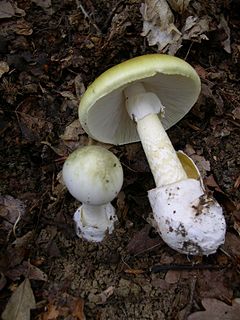
Amanita phalloides, commonly known as the death cap, is a deadly poisonous basidiomycete fungus, one of many in the genus Amanita. Widely distributed across Europe, but now sprouting in other parts of the world, A. phalloides forms ectomycorrhizas with various broadleaved trees. In some cases, the death cap has been introduced to new regions with the cultivation of non-native species of oak, chestnut, and pine. The large fruiting bodies (mushrooms) appear in summer and autumn; the caps are generally greenish in colour with a white stipe and gills. The cap colour is variable, including white forms, and is thus not a reliable identifier.
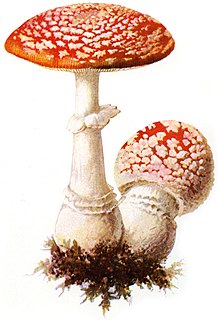
The genus Amanita contains about 600 species of agarics, including some of the most toxic known mushrooms found worldwide, as well as some well-regarded edible species. This genus is responsible for approximately 95% of the fatalities resulting from mushroom poisoning, with the death cap accounting for about 50% on its own. The most potent toxin present in these mushrooms is α-Amanitin.

Mushroom hunting, mushrooming, mushroom picking, mushroom foraging, and similar terms describe the activity of gathering mushrooms in the wild, typically for culinary use. This practice is popular throughout most of Europe, Australia, Japan, Korea, parts of the Middle East, and the Indian subcontinent, as well as the temperate regions of Canada and the United States.

Amanita pantherina, also known as the panther cap, false blusher, and the panther amanita due to its similarity to the true blusher, is a species of fungus found in Europe and Western Asia. The mushroom is psychoactive but also considered inedible and toxic, and can cause severe illness if eaten fresh.

Mushroom poisoning is poisoning resulting from the ingestion of mushrooms that contain toxic substances. Its symptoms can vary from slight gastrointestinal discomfort to death in about 10 days. Mushroom toxins are secondary metabolites produced by the fungus.

The blusher is the common name for several closely related species of the genus Amanita. A. rubescens or the blushing amanita, is found in Europe and eastern North America, and A. novinupta, also known as the new bride blushing amanita, is found in western North America. Both their scientific and common names are derived from the propensity of their flesh to turn pink on bruising, or cutting.

Amanita citrina, commonly known as the false death cap or citron amanita, is a basidiomycotic mushroom, one of many in the genus Amanita. It grows in silicate soil in the summer and autumn months. It bears a pale yellow or sometimes white cap, with white stem, ring and volva. Though not deadly, it is inedible and often confused for the lethal death cap.

Amanita echinocephala is a large, whitish or ivory-coloured mushroom with a characteristic spiny, or warty-looking cap. It lives on chalky soils with beech trees, and appears earlier than most mushrooms of similar size in southern England. It frequently occurs singly or in small groups, resulting in it being referred to as the solitary amanita or, more specifically, European solitary lepidella. It is very drought-tolerant. Amanita solitaria is a synonym and opinions are divided as to which name takes precedence.
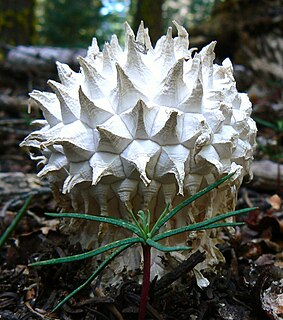
Calvatia sculpta, commonly known as the sculpted puffball, the sculptured puffball, the pyramid puffball, and the Sierran puffball, is a species of puffball fungus in the family Agaricaceae. Attaining dimensions of up to 8 to 15 cm tall by 8 to 10 cm wide, the pear- or egg-shaped puffball is readily recognizable because of the large pyramidal or polygonal warts covering its surface. It is edible when young, before the spores inside the fruit body disintegrate into a brownish powder. The spores are roughly spherical, and have wart-like projections on their surfaces.

Amanita flavoconia, commonly known as yellow patches, yellow wart, orange amanita, yellow-dust amanita or the American yellow dust amanita, is a species of mushroom in the family Amanitaceae. It has an orangish-yellow cap with yellowish-orange patches or warts, a yellowish-orange annulus, and a white to orange stem. Common and widespread throughout eastern North America, Amanita flavoconia grows on the ground in broad-leaved and mixed forests, especially in mycorrhizal association with hemlock.

Amanita vaginata, commonly known as the grisette or the grisette amanita, is an edible mushroom in the fungus family Amanitaceae. Unlike many other Amanita mushrooms, A. vaginata lacks a ring on the stem. The cap is gray or brownish, 5 to 10 centimetres in diameter, and has furrows around the edge that duplicate the gill pattern underneath. It has a widespread distribution in North America, and is thought to be part of a species complex that includes other similar-looking Amanitas.
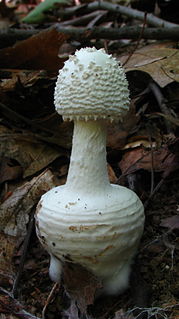
Amanita abrupta, commonly known as the American abrupt-bulbed amanita or the American abrupt-bulbed lepidella, is a species of fungus in the family Amanitaceae. Named for the characteristic shape of its fruit bodies, this white Amanita has a slender stem, a cap covered with conical white warts, and an "abruptly enlarged" swollen base. This terrestrial species grows in mixed woods in eastern North America and eastern Asia, where it is thought to exist in a mycorrhizal relationship with a variety of both coniferous and deciduous tree species.

Amanita daucipes is a species of fungus in the family Amanitaceae of the mushroom order Agaricales. Found exclusively in North America, the mushroom may be recognized in the field by the medium to large white caps with pale orange tints, and the dense covering of pale orange or reddish-brown powdery conical warts on the cap surface. The mushroom also has a characteristic large bulb at the base of its stem with a blunt short rooting base, whose shape is suggestive of the common names carrot-footed lepidella, carrot-foot amanita, or turnip-foot amanita. The mushroom has a strong odor that has been described variously as "sweet and nauseous", or compared to an old ham bone, or soap. Edibility is unknown for the species, but consumption is generally not recommended due its position in the Amanita subgroup Lepidella, which contains some poisonous members.

Amanita onusta, commonly known as the loaded Lepidella, the gunpowder Lepidella or the gunpowder amanita, is a species of fungus in the mushroom family Amanitaceae. It is characterized by its small to medium-sized fruit bodies that have white to pale gray caps crowded with roughly conical, pyramidal, or irregular gray warts. The stipe is whitish-gray with woolly or wart-like veil remnants, and at the base is a spindle- or turnip-shaped base that is rooted somewhat deeply in the soil. The species is distributed in eastern North America, from Nova Scotia to Mexico, and may be found growing on the ground in deciduous forests, particularly those with oak, hickory and chestnut. Fruit bodies smell somewhat like bleaching powder, and their edibility is unknown, but possibly toxic.

Amanita atkinsoniana, also known as the Atkinson's amanita, is a species of fungus in the family Amanitaceae. It is found in the northeastern, southeastern, and southern United States as well as southern Canada, where it grows solitarily or in small groups on the ground in mixed woods. The fruit body is white to brownish, with caps that measure up to 12.5 cm (5 in) in diameter, and stems up to 20 cm long and 2.5 cm (1 in) thick. The surface of the cap is covered with reddish-brown to grayish-brown conical warts. The stem has a bulbous base covered with grayish-brown scales. The fruit bodies smell faintly like bleaching powder. Although not known to be poisonous, the mushroom is not recommended for consumption.

Amanita ravenelii, commonly known as the pinecone lepidella, is a species of fungus in the family Amanitaceae. The fruit bodies are medium to large, with caps up to 17 cm (6.7 in) wide, and a stem up to 25 cm (9.8 in) long and 3 cm (1.2 in) thick. The warts on the whitish cap surface are large—up to 6 mm (0.24 in) wide and 4 mm (0.16 in) high. The stem has a large bulb at its base, covered with whitish to brownish scales, that may root several centimeters into the soil. The ring on the stem is thick and cotton- or felt-like. It is widely distributed in mixed and deciduous forests of the southeastern United States, where it grows solitarily or in groups on the ground in late summer and autumn. The mushrooms have a unique odor resembling bleaching powder.
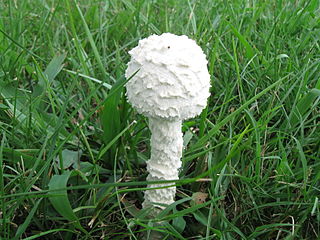
Saproamanita thiersii, commonly called Thiers' lepidella, is a North-American saprotrophic basidiomycete fungus in the genus Saproamanita. It is a white mushroom originally described from Texas but today found in nine states of North America. It was named after Harry Delbert Thiers. The cap of this small mushroom is white and convex, measuring 35–100 mm (1.4–3.9 in) and covered by volval remnants. It is sticky to the touch when wet. The gills are variable in length and number and are densely packed in some specimens and widely spaced in others. They are not attached to the stipe, which is 8–20 cm (3–8 in) long and about 1 cm (0.4 in) thick, with a white ring. The spores measure 7.8–9.8 by 7.3–9.0 µm and are roughly spherical in shape. The spore print is white.

Amanita augusta is a small tannish-brown mushroom with cap colors bright yellow to dark brown and various combinations of the two colors. The mushroom is often recognizable by the fragmented yellow remnants of the universal veil. This mushroom grows year-round in the Pacific Northwest but fruiting tends to occur in late fall to mid-winter. The fungus grows in an ectomycorrhizal relationship with hardwoods and conifers often in mixed woodlands.





















